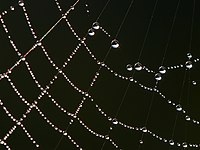
Photo from wikipedia
The use of scaled-down micro-bumps in miniaturized consumer electronic products has led to the easy realization of full intermetallic solder bumps owing to the completion of the wetting layer. However,… Click to show full abstract
The use of scaled-down micro-bumps in miniaturized consumer electronic products has led to the easy realization of full intermetallic solder bumps owing to the completion of the wetting layer. However, the direct contact of the intermetallic compounds (IMCs) with the adhesion layer may pose serious reliability concerns. In this study, the terminal reaction of the Ti adhesion layer with Cu–Sn IMCs was investigated by aging the micro-bumps at 200 °C. Although all of the micro-bumps transformed into intermetallic structures after aging, they exhibited a strong attachment to the Ti adhesion layer, which differs significantly from the Cr system where spalling of IMCs occurred during the solid-state reaction. Moreover, the difference in the diffusion rates between Cu and Sn might have induced void formation during aging. These voids progressed to the center of the bump through the depleting Cu layer. However, they neither affected the attachment between the IMCs and the adhesion layer nor reduced the strength of the bumps. In conclusion, the IMCs demonstrated better adhesive behavior with the Ti adhesion layer when compared to Cr, which has been used in previous studies.
Journal Title: Materials
Year Published: 2022
Link to full text (if available)
Share on Social Media: Sign Up to like & get
recommendations!